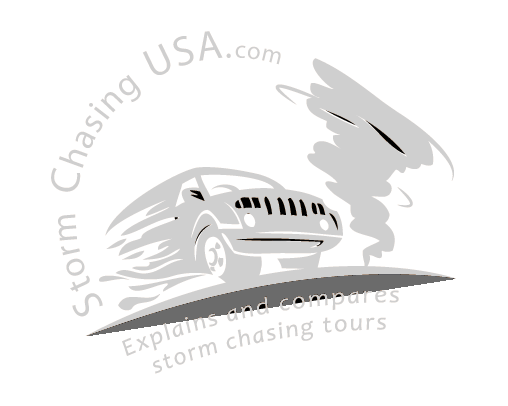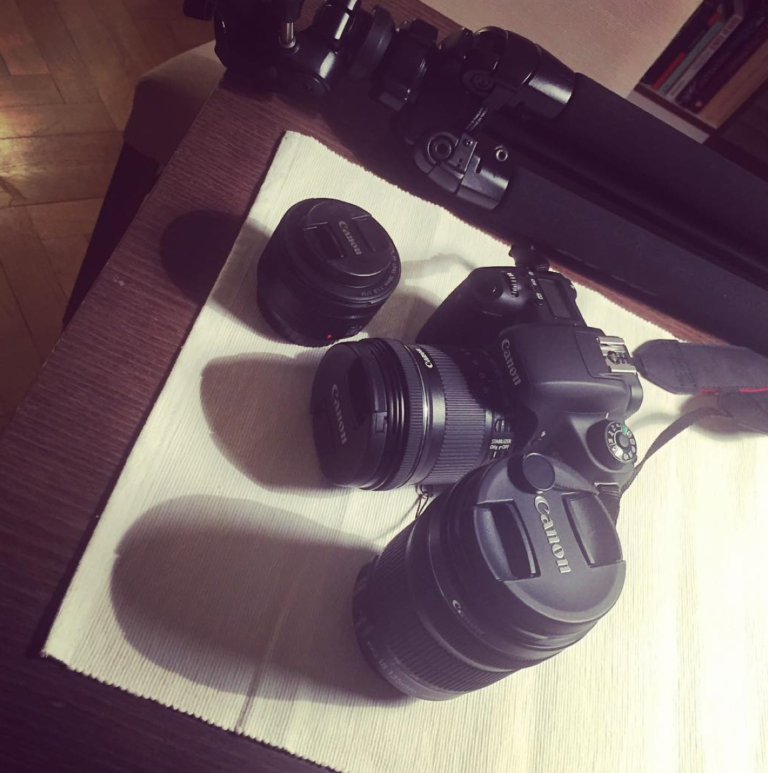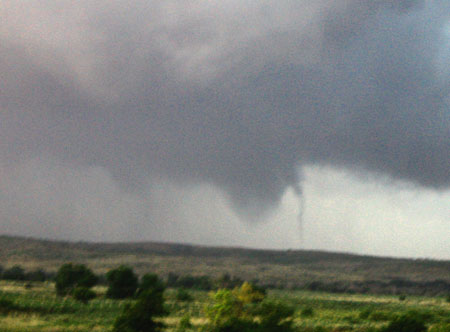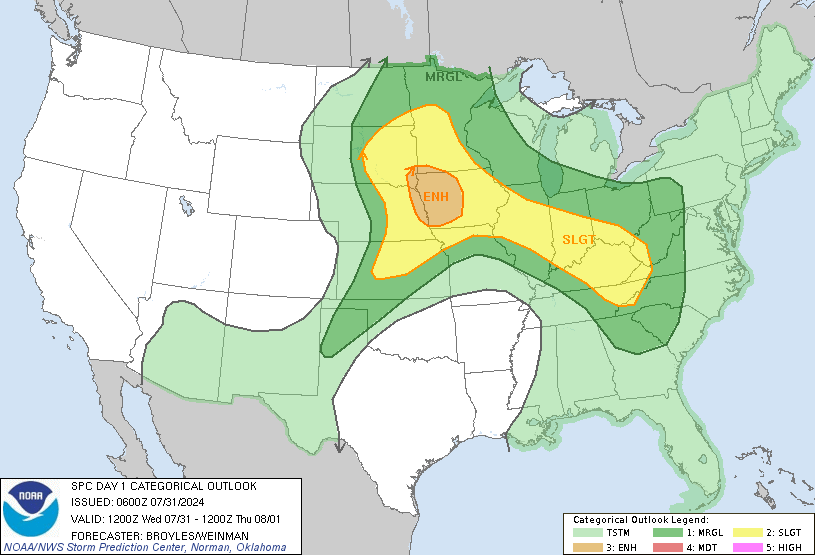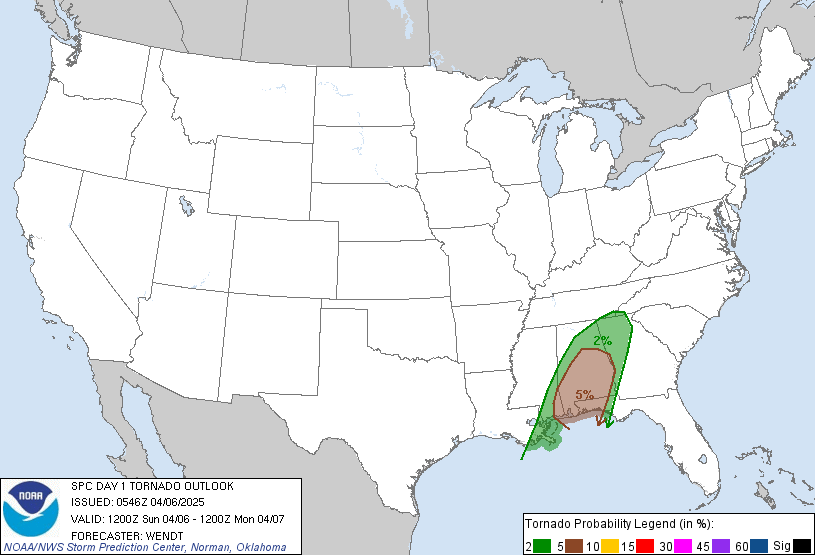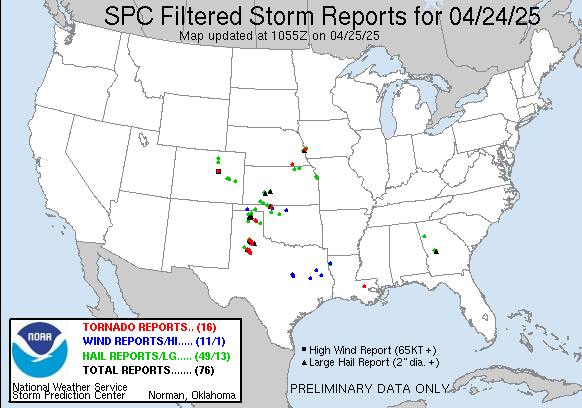Before my first chase season in 2009 I bought my first systematic camera, a Canon 450. I brought it along together with a pocket camera for videos. My second season, 2012, I used the same setup. The videos were horrible but the photos were good.
I managed to borrow a 70-300mm Sigma telescope lens (without Image Stabilizer) from my sister for 2013 and also bought a cheap tripod at Walmart as well as a cheap Sony video camera for that season. Last season I added a GoPro to the collection, which I mainly used as a car-cam in front of the car.
The main event last year for me was Canadian, TX, which was a tornado outbreak and one of the main events of that season. I was happy to be there and we saw all the tornadoes but we were rather unfortunate with our positioning for them. That, but more importantly, my inability of handle the camera made several of my photos come out like this:
The double tornado photograph above (slightly cropped) was shot with my 18-50mm (at 50mm) with an ISO 800 which probably was too much for my camera and a major cause for the general graininess in the photo. I also had some motion blur in it although nothing severe. Still, the quality is so bad and off-focus that I believe I maybe also had manual focus set on. I am not sure about the latter but the focus is really nowhere in this photo. The result was a horrible photo, unfortunately.
If I would have had my 300mm on, it may have been better but the problem is knowing when to put it on since you don’t want your 70-300mm telescope lens on when something happens nearby so the 18-50mm was my primary option. I was not even close to have time to switch either.
I wanted to upgrade my entire gear so I got off to buy a new camera and new lenses and created this thread on StormTrack.org where I got lots of good help (thanks everyone!).
Choosing camera
Outside of storm chasing I also do a bit of safaris but photographing storms was my #1 priority when I went looking for a camera. There were a few things I needed for my new camera:
- General upgrade in quality – To be honest I did not know that the lack of quality in terms of ISO was a problem with my old camera but I wanted a general upgrade in quality.
- Ability to record video – I did not want to have to use one hand to film and one to take pictures with. I wanted to be able to record HD-video with my camera, if needed. This was a major reason why I wanted to upgrade of the camera itself.
- Flip-screen – Not so much for storm chasing but I had found myself a couple of times needing one to take photos when I couldn’t look through the ocular.
I reduced my options to only Canon-cameras since my last two cameras had been Canon and I have always liked the quality of them. It made sense and made my list shorter and thus easier. I assume a Nikon (or any other major brand) would have been just as good. I never really bothered about mirror-less cameras since it felt like a completely different type of camera.
My options for Canon were in three different series with numbers like 7, 70 or 700’s. The single number-cameras are the highest quality ones in the Canon-series, usually with a Full Frame sensor. That would be awesome to have but felt out of my league – I wouldn’t be able to match the technology with my skill and it was much more expensive. I did not learn about the 70-series until I got home so my options were cameras in the 700-series. Since the 760D had everything I needed in terms of video, flip screen etc and was slightly better than the 750 I went for that one. Basically I bought the newest/best one in that range.
Choosing lenses
More importantly than the camera house was the choice of lenses. I will take you through my thoughts and trade-offs with each of them.
50mm fixed lens
My 760D came with a good quality lens: a fixed Canon f/1.8 50mm. In the StormTrack forum-thread I had read about some actually having that as their primary lens arguing that a good shot, even at a distance, with that lens would still beat a shot with (possible) motion blur from a telescope lens with a lower quality lens.
Basically, digitally zooming in images from this lens would turn out better than optically zooming with a bad telescope lens. I was not convinced and would not really dare to have it as my primary lens in case I needed to photograph something at a wider angle, for example. Having no zoom-option while chasing could be highly frustrating, I assume.
Still, with the 1.8 aperture and its high light sensitivity it should be great for shots under dark conditions. This will most likely be my “after 7.30 p.m.”-lens and may end up being the Joker in my list of lenses.
Primary 18mm+ lens (with zoom)
What I learned from this, and previous seasons, was that I need a lens that could do some zooming while still being my “work horse”-lens. I have found during many chases that we have been positioned quite far from tornadoes etc because the road network, time, safety etc would not allow us to get any closer. Thus, I needed my camera to “bring me closer” while still work at close range. For this lens I was not looking at real telescope lenses like my old Sigma 70-300mm.
I was choosing between:
- Sigma 17-70mm f/2.8-4 (good aperture, less zoom)
- Canon 18-130mm f/3.5-5.6 (decent aperture, good zoom)
- Canon 18-200mm f/3.5-5.6 (decent aperture, great zoom, more expensive)
- Tamron 18-55mm f/2.8 (great aperture, no real telescope zoom)
It was mostly a trade-off between aperture and zoom, which in reality was a trade-off between speed and zoom. I would never really need to use the f/2.8 for other reasons than the larger inlet of light would make photographing in bad lighting conditions better. With a better aperture I could have faster shutter time which would, in turn, reduce possible motion blur. Better aperture would make it easier to get good shots in bad lighting conditions.
The Tamron 18-55mm, despite having great aperture quickly was quickly removed from my short-list. If I used that one I would definitely need a real telescope lens as well. What I learned before is that it is often difficult to know when to have it on or not and switching lenses takes precious time in those cases.
The most difficult decision was between the Sigma 17-70 and the Canon 18-130. In the end, I realized 70mm would not be enough either. The extra aperture would be useful in darker conditions but I would always feel that I would want that extra zoom when I could not get closer to a tornado for example. 70mm is not really a telescope in that sense. It was a hard choice but I cut it out from my list, hoping I will not miss it when I am back to dusky light situations this season.
My last option was between the Canon 18-130mm and the Canon 18-200mm. The major differences between them was that the Canon 18-200mm, outside of the obviously better zoom, was about 50% more expensive. They both, obviously, had the same wide angle that would be useful in many events.
Some research on the Canon 18-200mm proved that the lens had some bad reviews in terms of the image quality. Many users, however, were positively surprised anyway in a way like: “I would not imagine a camera with such a wide range of zoom would have such surprisingly good image quality”. Many stated, however, that it surely was a trade-off with image quality to have that wide range and especially in the outer ends (18mm and 200mm) where I expect to use it the most. Basically, my feeling was that I would have a great range which would expand the field of where I would use it but end up getting photos that were always a bit sub-par.
Considering that the 130mm zoom will often be very good and that the image quality should be better, as well as it was cheaper I decided to go with the Canon 18-130mm. Especially since this left some room in my budget for a wide angle lens!
Wide angle lens
The decision to buy a wide angle lens was more of a: Should I buy one or not? rather than which one should I buy. At first I was sure I would not buy one since I felt my typical shots were more often missing zoom than wide angles. Many of the storm chasers I discussed with, however, mentioned that their wide angle is the one they use the most, by far!
I had the pleasure to chase with Allen Dietrich last year who was not only a great guy but also an amazing photographer. His advice of getting a wide angle had a strong impact since I had seen many of his photographs and what he managed to squeeze out of the very same situations I had been in!
Another strong reason I decided to go with a wide angle was that when I went through my collection of photos from previous seasons I realized I had used the iPhone panorama shots a lot and there were also many situations/photos when I knew I would have liked to have a wider angle – especially when standing underneath, or close to, a supercell. That convinced me.
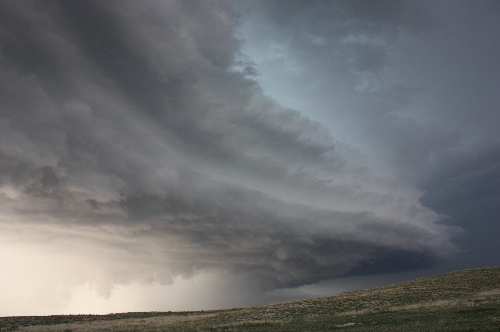
So, I decided to go with one but was quickly discouraged. Wide angle lenses are expensive! I did however manage to find one that had received great reviews despite the fact that it was half the price of other wide angle lenses: Canon 10-18mm. I never really tried anything else than that one.
Tripod and extra batteries
Lastly, upgrading every part of my gear kind of makes you having to go all the way. I used to have my cheap Walmart tripod but it has gotten lost along the way. It was too light anyway and I would never really dare to leave my camera on it during windy conditions.
Considering that motion blur is a common reason for blur in my photos and the fact that I absolutely need one to take photos of lightning and decided to go with a (good) one. After spending quite a bit more than I budgeted for I decided to go with a professional one but yet, a tripod in the lower end. It looked sturdy enough for windy conditions and was reasonably light. My major concern with tripods is that they take time. They take time to bring in and out of the vehicle but, with time, will be very very useful – especially during bad light conditions. I am glad I bought one.
Lastly, I decided to buy an extra battery for the camera as well as for my GoPro. Having this entire setup is pointless if my camera shuts down without any chance of recharging in the middle of a chase. Since I expect to use video I also expect to drain the battery faster.
Quick testing
I have not been able to really test the lenses but I am getting used to the camera. It seems to be really good! Features like being able to connect with it through WiFi and quickly download photos to my iPhone was great. Being able to remotely take photos with it with my iPhone will remove potential motion blur from pushing the camera button (details but I tried it and it was a difference). Its aptitude in removing noise in high ISO will be very useful as well.
The 50mm really takes amazing photos and especially in the dark. I managed to photograph stars, for the first time ever really, in downtown Stockholm with city lights etc. If I am in a position where I can use it and have time to change to it, this will probably be me “go to”-lens.
The 10-18mm was a lot more fun to play around with than I thought. It gives another dimension to any given view. I am quite sure I will use this a lot for structure shots or when I end up underneath a storm.
The 18-130mm has been fun testing out from my balcony since I have a great view with many details to look at. I realized it will be difficult to get perfect shots while zoomed in on 130mm unless I have the tripod or really fast shutter speed. With a tripod, however, it will be great. My plan is to have this on at most times while chasing but I will re-evaluate it after a while.
I will also bring my Canon 450 to use as a backup camera but, more importantly, since I can use another lens quickly on it. Most likely I will be using the wide angle on this one.
Setup and settings
How I will use the cameras and the lenses will be something I have to test further on. Since many of my photos that turned out bad was due to the wrong settings (like accidently having manual focus without noticing) I will spend some time before my season to experiment with settings and preferable programs. Often I end up using Full Automatic-setting on the camera in order to make sure I get a decent photo instead of messing around with settings when I don’t have enough time.
I will write another blog post (and possibly another forum thread) about that endeavour.
